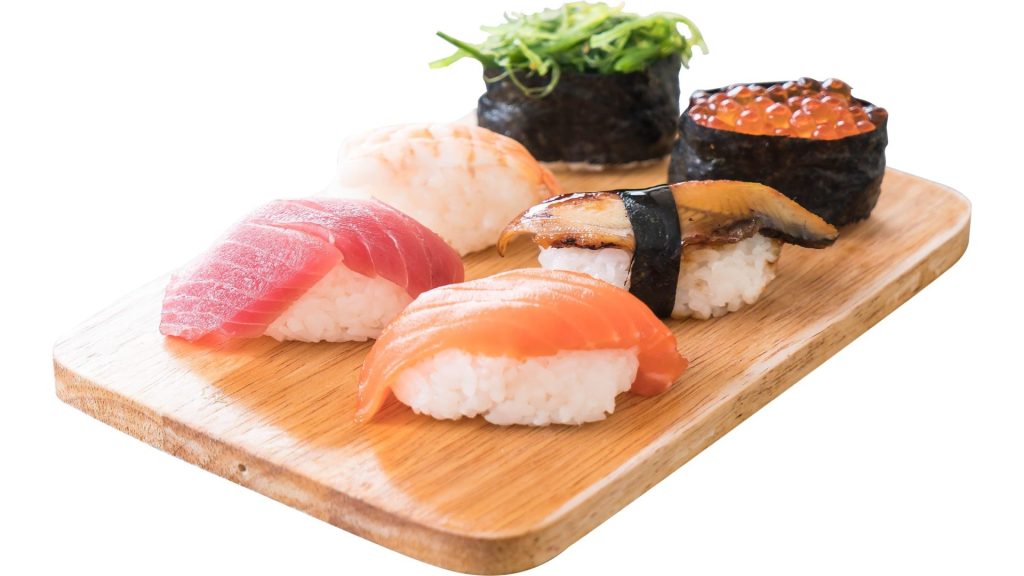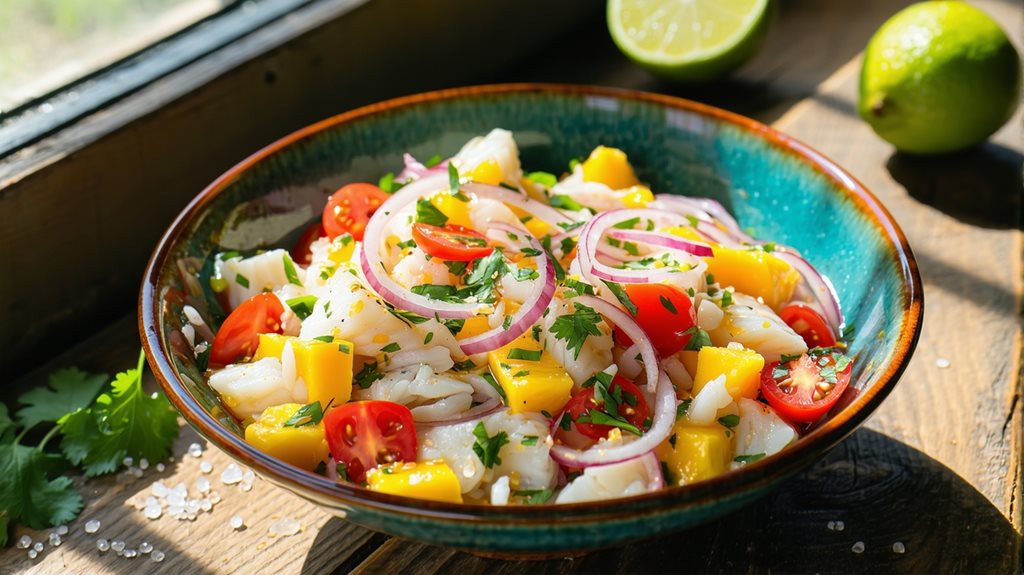What is Hamachi Sushi? Hamachi sushi is a popular Japanese cuisine that has made its way to North America.
Hamachi is a type of sushi-grade yellowtail fish that is known for its rich flavor and buttery texture. It is a versatile fish that can be served in many different ways, including sashimi, nigiri, and rolls.
Understanding hamachi is important when it comes to making the perfect hamachi sushi.
Hamachi is often confused with other types of fish, such as yellowtail and amberjack.
It is known for its high fat content, which gives it a rich, buttery flavor and a melt-in-your-mouth texture.
Key Takeaways
- Hamachi sushi is a popular Japanese cuisine that features sushi-grade yellowtail fish.
- Hamachi is a type of yellowtail that is known for its rich flavor and buttery texture.
- Understanding hamachi is important when it comes to making the perfect hamachi sushi.
Understanding Hamachi
Hamachi is a type of sushi-grade yellowtail fish that is popular in Japanese cuisine.
It is also known as Japanese amberjack, amberjack, or Seriola quinqueradiata. The fish is native to the Pacific Ocean and is caught in the wild or farmed.
Yellowtail is a versatile fish that can be enjoyed in various ways, including as sashimi, nigiri, or in sushi rolls.
The texture of hamachi is firm and buttery, with a mild and slightly sweet flavor that is not overpowering. It is a great choice for those who are new to sushi or prefer a milder taste.
In Japan, hamachi is often used in traditional sushi dishes such as hamachi nigiri, hamachi sashimi, and hamachi maki rolls. The fish is also enjoyed in other countries, including the United States, where it is commonly served in sushi restaurants.
When it comes to sourcing hamachi, there are two main options: farm-raised or wild-caught.
Farm-raised hamachi is a more sustainable option and tends to have a milder flavor.
Wild-caught hamachi, on the other hand, has a stronger taste and is considered to be more flavorful.
Hamachi in Japanese Cuisine

Hamachi is a popular ingredient in Japanese cuisine, especially in sushi and sashimi dishes.
It is often used in nigiri sushi, where a small piece of fish is placed on top of a ball of sushi rice. It can also be used in maki sushi, where it is rolled with other ingredients in seaweed and rice.
In addition to sushi, Hamachi is also commonly served as sashimi, where it is thinly sliced and served raw with soy sauce and wasabi.
It is important to note that only sushi-grade Hamachi should be consumed raw, as it has been properly handled and prepared to ensure safety.
Hamachi is also a popular ingredient in donburi, a Japanese rice bowl dish. Hamachi donburi typically consists of rice topped with grilled or broiled Hamachi, along with vegetables and other toppings.
Another popular Hamachi dish is Hamachi kama, which refers to the collar or cheek of the fish. This cut is typically grilled or broiled and served with soy sauce and lemon.
Overall, Hamachi is a versatile and delicious ingredient in Japanese cuisine, and its popularity continues to grow in North America and beyond.
What is Hamachi Sushi
Hamachi Sushi is a type of sushi that features yellowtail fish as its main ingredient. Hamachi, also known as Japanese amberjack, is a popular fish in both Japan and the US.
It is known for its rich buttery flavor and smooth texture, making it a favorite among sushi enthusiasts.
To make Hamachi Sushi, sushi rice is seasoned with vinegar, salt, and sugar.
The seasoned rice is then shaped into small oblong shapes and topped with a slice of Hamachi. The sushi is typically served with wasabi, soy sauce, and pickled ginger.
To make sushi, a sheet of nori is placed on top of a bamboo mat. The seasoned rice is then spread over the nori sheet, leaving a small border at the top.
The Hamachi is then placed on top of the rice, and the sushi is rolled up using the bamboo mat.
Hamachi Sushi is typically served as nigiri sushi, which is a type of sushi that features a small ball of seasoned rice topped with a slice of fish.
It can also be served as part of a sushi roll, which consists of seasoned rice and other ingredients wrapped in a nori sheet.
Taste and Texture of Hamachi
Hamachi is a popular sushi-grade yellowtail fish with a rich, buttery flavor and a smooth, creamy texture.
The taste of hamachi is often described as sweet and savory, making it a favorite among sushi lovers.
The texture of hamachi is delicate and tender, with a melt-in-your-mouth sensation that is highly sought after in sushi. The fatty content of the fish contributes to its creamy texture, which is why it is often referred to as the “foie gras of the sea”.
When prepared properly, hamachi can be a truly indulgent culinary experience. It is often served raw as sashimi or sushi, but it can also be grilled, baked, or broiled to enhance its flavor and texture.
Overall, the taste and texture of hamachi make it a highly desirable ingredient in Japanese cuisine. Its rich, buttery flavor and creamy texture make it a versatile fish that can be enjoyed in a variety of preparations.
How to Make Hamachi Sushi

Making Hamachi Sushi may seem daunting, but with the right ingredients and technique, it can be a fun and rewarding experience. Here’s a step-by-step guide to making Hamachi Sushi at home.
Ingredients
To make Hamachi Sushi, you’ll need the following ingredients:
- Sushi rice
- Hamachi (yellowtail) fish
- Nori sheets
- Wasabi
- Soy sauce
- Sugar
- Salt
Equipment
You’ll also need the following equipment:
- Bamboo mat
- Blowtorch (optional)
Steps
- Start by cooking the sushi rice according to the package instructions. Once it’s cooked, mix it with a mixture of vinegar, sugar, and salt to create the perfect sushi rice.
- Next, prepare the Hamachi fish by filleting it and cutting it into thin slices.
- Place a Nori sheet on top of the bamboo mat and spread a thin layer of sushi rice over it, leaving a small border around the edges.
- Add a small amount of wasabi to the center of the rice and place a few slices of Hamachi on top.
- Use the bamboo mat to roll the sushi into a tight cylinder, making sure to tuck in the edges as you go.
- Once you’ve rolled the sushi, use a sharp knife to cut it into bite-sized pieces.
- If you want to add a little extra flavor and texture to your Hamachi Sushi, you can use a blowtorch to lightly sear the fish before serving.
- Serve the sushi with soy sauce and extra wasabi on the side.
With these simple steps, you can create delicious and authentic Hamachi Sushi at home.
Pairings and Accompaniments
Hamachi sushi is best enjoyed with the right pairings and accompaniments. The following are some of the best options to complement the delicate flavor of hamachi:
- Scallions: The mild onion flavor of scallions pairs well with hamachi. It adds a refreshing crunch to the sushi.
- Eel: Eel is a rich and savory addition to hamachi sushi. The combination of the two flavors creates a unique taste experience.
- Daikon: The crisp texture and mild flavor of daikon radish make it a great pairing for hamachi sushi. It also helps cleanse the palate between bites.
- Shiso Leaf: Shiso leaf is a traditional Japanese herb that adds a hint of mint and basil to hamachi sushi. It also provides a pop of color to the dish.
- Jalapeno: For those who like a bit of heat, jalapeno adds a spicy kick to hamachi sushi. It also complements the mild flavor of the fish.
When it comes to drinks, hamachi sushi pairs well with a variety of options. Fruity sake and daiginjo are great choices for those who prefer sake. For wine lovers, sauvignon blanc, pinot grigio, and chardonnay are all good options that won’t overpower the delicate flavor of hamachi.
Varieties of Hamachi Sushi
Hamachi sushi is a popular choice among sushi lovers due to its buttery texture and rich flavor. There are several varieties of hamachi sushi, each with a unique taste and preparation method.
Buri and Kanpachi
Buri and kanpachi are two types of yellowtail fish that are commonly used in sushi.
Buri is the adult version of the fish, while kanpachi is the juvenile version. Buri has a firmer texture and a more pronounced flavor, while kanpachi has a softer texture and a milder flavor.
Both are delicious and often used interchangeably in sushi dishes.
Nigirizushi
Nigirizushi is a type of sushi that consists of a small ball of rice topped with a slice of fish or other seafood.
Hamachi nigiri is a classic sushi dish that features a slice of hamachi on top of a small ball of sushi rice.
The fish is typically lightly seared or served raw, and is often garnished with wasabi, soy sauce, or other toppings.
Uramaki and Sushi Rolls
Uramaki and sushi rolls are two popular types of sushi that often feature hamachi as a filling. Uramaki, also known as inside-out rolls, are made by rolling the sushi rice on the outside of the seaweed wrap.
Hamachi can be used as a filling along with other ingredients such as avocado, cucumber, or crab meat.
Sushi rolls are made by rolling the seaweed wrap around the filling, with the rice on the inside.
Hamachi sushi rolls often feature a combination of hamachi, avocado, and cucumber, and may be topped with tobiko (flying fish roe) or other garnishes.
Amberjack Sushi
Hamachi is sometimes referred to as amberjack, which can cause confusion among sushi lovers. While hamachi is a type of yellowtail fish, amberjack refers to a different species of fish altogether.
However, some sushi restaurants may use the terms interchangeably, so it’s important to clarify with your server if you’re unsure which fish is being used in your sushi dish.
Sourcing Quality Hamachi
When it comes to sourcing quality hamachi for sushi, it’s important to choose a reputable supplier. A fishmonger or seafood wholesaler can help you find the freshest and highest quality hamachi available.
One such supplier is Catalina Offshore Products, which sources hamachi from the Pacific Ocean. They work with local fishermen to ensure sustainability and quality.
When purchasing hamachi, look for fish that is bright and shiny with clear eyes and firm flesh.
Hawaii is also known for its high-quality hamachi, which is often served as sashimi.
Some of the best hamachi comes from the Kanto region of Japan, where it is known as warasa or mejiro.
When selecting hamachi, be sure to ask your supplier about the fish’s origin and how it was caught. Wild-caught hamachi is generally considered to be of higher quality than farmed hamachi, which can be prone to disease and parasites.
In summary, sourcing quality hamachi for sushi requires finding a reputable supplier and selecting fish that is fresh, firm, and sustainably caught. Whether you choose hamachi from the Pacific Ocean, Hawaii, or Japan, be sure to ask questions and choose a supplier you can trust.
Popular Hamachi Dishes
Hamachi, or yellowtail, is a versatile fish that can be enjoyed in a variety of dishes. Here are some popular hamachi dishes that you can find at many sushi restaurants:
- Hamachi Sashimi: Thinly sliced hamachi served raw with soy sauce and wasabi is a classic dish that lets the flavor and texture of the fish shine through.
- Hamachi Nigiri: Nigiri is a type of sushi where a small ball of sushi rice is topped with a slice of fish. Hamachi nigiri is a popular choice due to the fish’s buttery texture and mild flavor.
- Hamachi Roll: A hamachi roll typically includes hamachi, avocado, and cucumber wrapped in seaweed and rice. Some variations may also include spicy mayo or other ingredients.
- Hamachi Kama: Hamachi kama is the collar of the fish, which is a fatty and flavorful cut. It is usually grilled and served with a side of ponzu sauce.
- Hamachi Teriyaki: Hamachi can also be prepared with a sweet and savory teriyaki sauce. This dish is often served with steamed rice and vegetables.
Many sushi restaurants also offer lunch specials that include hamachi dishes at a discounted price. These specials may include a combination of nigiri, rolls, or sashimi, along with miso soup and a side salad..
Hamachi Sushi Delivery Options
Hamachi sushi is a popular dish that can be enjoyed in various settings, including at home. With the rise of food delivery services, it is now easier than ever to have hamachi sushi delivered straight to your doorstep.
Here are some of the delivery options available for hamachi sushi:
Delivery Apps
Delivery apps such as Uber Eats, Grubhub, and DoorDash offer a variety of sushi restaurants that provide hamachi sushi delivery options.
Customers can browse menus, place orders, and track their deliveries all through the app.
These apps are convenient for those who want to enjoy hamachi sushi without leaving their homes.
Restaurant Websites
Many sushi restaurants have their own websites where customers can place orders for delivery or takeout.
These websites often have their own delivery system or partner with delivery services such as Postmates or Seamless.
Ordering directly from the restaurant’s website can sometimes be more cost-effective than using a delivery app.
Meal Kit Services
Meal kit services such as Blue Apron and HelloFresh offer hamachi sushi meal kits that can be delivered to your doorstep.
These meal kits typically include all the necessary ingredients to make hamachi sushi at home, including sushi rice, hamachi, and nori.
Meal kit services are a great option for those who want to try making hamachi sushi themselves.



Konnichiwa! (Hello!) I'm Pat Tokuyama, a Japanese tofu cookbook author, who travels for music, food, and adventure. If you like Japanese tea, checkout some of the newestorganic japanese tea, matcha bowls and noren and more!
** Curious about the Plant Based Japanese Cooking Club? ** Learn more here!
Takeout
For those who prefer to pick up their food, many sushi restaurants offer takeout options for hamachi sushi. Customers can call ahead or place their orders online and pick up their food at the restaurant.
Takeout is a great option for those who want to enjoy hamachi sushi on the go or in the comfort of their own homes.
In conclusion, there are various delivery options available for hamachi sushi, including delivery apps, restaurant websites, meal kit services, and takeout. Customers can choose the option that best suits their needs and preferences.






Konnichiwa! (Hello!) I'm Pat Tokuyama, a Japanese tofu cookbook author, who travels for music, food, and adventure. If you like Japanese tea, checkout some of the newestorganic japanese tea, matcha bowls and noren and more!
** Curious about the Plant Based Japanese Cooking Club? ** Learn more here!